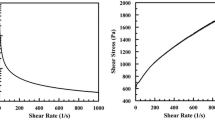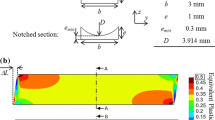Abstract
A methodology for continuous monitoring of grease degradation subjected to mechanical shearing is proposed. It is hypothesized that the mechanical degradation of grease is akin to the running-in process in a tribo-pair with both transient and steady-state regimes. To validate the hypothesis, a series of mechanical shearing tests are performed on three grades of grease: NLGI 00, NLGI 1, and NLGI 2.5 by employing a rheometer. From the results, a more effective method using the entropy generation rate is proposed for continuous monitoring of grease degradation. The proposed method is extended to estimate the time for a grease subjected to mechanical shearing to degrade to a lower grade. The efficacy of this method is demonstrated via long duration testing in a custom-built ball-bearing test apparatus.


















Similar content being viewed by others
References
Lugt, P.M.: Grease lubrication in rolling bearings. Wiley, New York (2013)
National Lubricating Grease Institute (NLGI): Lubricating grease guide, 2nd edn. NLGI, Kansas City (1987)
Lugt, P.M.: A review on grease lubrication in rolling bearings. Tribol. Trans. 52(4), 470–480 (2009)
Gow, G.: Lubricating grease. In Chemistry and technology of lubricants, pp. 411–432. Springer, Dordrecht (2010)
Baumoel, J. Fluoro-ether grease acoustic couplant. U.S. Patent 4,929,368, (1990)
James, H. E., Walter H. M. Shaft support and lubricating arrangement. U.S. Patent 2,919,962, (1960)
Singh, T., Banerjee, S.K., Ravi, K.: Grease composition for lubrication of journal bearings used in sugar mill, pp. 23–26. Mumbai, Greasetech India (2010)
Cobb, L.D.: Grease lubrication of ball bearings. Lubr. Eng. 8, 120–124 (1952)
Kawamura, T., Minami, M., Hirata, M.: Grease life prediction for sealed ball bearings. Tribol. Trans. 44(2), 256–262 (2001)
Lundberg, J.: Grease lubrication of roller bearings in railway wagons. Part 1: field tests and systematic evaluation to determine the optimal greases. Ind. Lubr. Tribol. 52(1), 36–43 (2000)
Baker, A.E.: Grease bleeding—a factor in ball bearing performance. NLGI Spokesm. 22, 271–279 (1958)
Lundberg, J., Berg, S.: Grease lubrication of roller bearings in railway wagons. Part 2: laboratory tests and selection of proper test methods. Ind. Lubr. Tribol. 52(2), 76–85 (2000)
Cann, P.M., Doner, J.P., Webster, M.N., Wikstrom, V.: Grease degradation in rolling element bearings. Tribol. Trans. 44(3), 399–404 (2001)
Ito, H., Tomaru, M., Suzuki, T.: Physical and chemical aspects of grease deterioration in sealed ball bearings. Lubr. Eng. 44(10), 872–879 (1988)
Wilson, A.R.: The relative film thickness of grease and oil films in rolling bearings. Proc. Inst. Mech. Eng. 193, 185–192 (1979)
Booser, E.R., Khonsari, M.M.: In: Chung, Y.W., Wang, Q.J. (eds.) Grease and grease life, encyclopedia of tribology, pp. 1555–1561. Springer Science, New York (2013)
Khonsari, M.M., Booser, E.R., Miller, R.: How grease keep bearings rolling. Mach. Des. 82, 54–59 (2010)
Fukunaga, K.: Allowable surface durability in grease lubricated gears. Tribol. Trans. 31(4), 454–460 (1988)
Krantz, T. L., Robert F. H. A: Study of spur gears lubricated with grease-observations from seven experiments. 58th Meeting of the Society for Machinery Failure Prevention Technology (MFPT) NASA, pp. 1–15 (2005)
Schultheiss, H., Stemplinger J. P., Thomas T., Stahl, K.: Influences on failure modes and load-carrying capacity of grease-lubricated gears. In International Conference on Gears, Munich, pp. 5–7 (2015)
Harris, C.G., Williams, J.H., Davies, A.: Condition monitoring of machine tools. Int. J. Prod. Res. 27(9), 1445–1464 (1989)
Ming, Z.Y.H.Y.Z.: Development of slide-way sealing grease 7035 for sintering machine. Synth. Lubr. 1, 005 (2006)
Aranzabe, A., Estibaliz, A., Arrate, M., Raquel, F., Jesus, T., Jo, A., Raj, S.: Comparing different analytical techniques to monitor lubricating grease degradation. NLGI Spokesm-Including NLGI Annual Meeting-National Lubricating Grease Institute 70(6), 17–30 (2006)
Rezasoltani, A., Khonsari, M.: On monitoring physical and chemical degradation and life estimation models for lubricating greases. Lubricants 4(3), 34 (2016)
ASTM standard no. D 1831-88. Standard test method for roll stability of lubricating grease. In: Annual book of ASTM standards. American Society for Testing and Materials, Philadelphia (1991)
ASTM standard no. D 2 17-88. Standard test methods for cone penetration of lubricating grease. In: Annual book of ASTM standards. American Society for Testing and Materials, Philadelphia (1991)
Lundberg, J., Hoglund, E.: A new method for determining the mechanical stability of lubricating greases. Tribol. Int. 33(3–4), 217–223 (2000)
Rezasoltani, A., Khonsari, M.M.: On the correlation between mechanical degradation of lubricating grease and entropy. Tribol. Lett. 60(1), 1–4 (2015)
Zhou, Y., Bosman, R., Lugt, P.M.: A model for shear degradation of lithium soap grease at ambient temperature. Tribol. Trans. 61(1), 61–70 (2018)
Rezasoltani, A., Khonsari, M.M.: An engineering model to estimate consistency reduction of lubricating grease subjected to mechanical degradation under shear. Tribol. Int. 103, 465–474 (2016)
Kuhn, E.: Correlation between system entropy and structural changes in lubricating grease. Lubricants 3(2), 332–345 (2015)
Kuhn, E.: Tribological stress of lubricating greases in the light of system entropy. Lubricants 4(4), 37 (2016)
Lijesh, K.P., Khonsari, M.M., Satish, V.K.: On the integrated degradation coefficient for adhesive wear: a thermodynamic approach. Wear 408, 138–150 (2018)
Lijesh, K.P., Khonsari, M.M.: On the onset of steady state during transient adhesive wear. Tribol. Int. 130, 378–386 (2019)
Lijesh, K.P., Khonsari, M.M.: On the degradation of tribo-components in boundary and mixed lubrication regimes. Tribol. Lett. 67, 12 (2019)
Acknowledgements
This research was conducted at LSU Center for Rotating Machinery and funded in part by NLGI (LSU #46895). The authors gratefully acknowledge this support.
Author information
Authors and Affiliations
Corresponding author
Additional information
Publisher's Note
Springer Nature remains neutral with regard to jurisdictional claims in published maps and institutional affiliations.
Appendix
Appendix
Figure 19 shows the schematic representation of the rheometer and the control volume considered for the present work. The grease is placed between the stationary surface and vane and is sheared by rotating the vane at an angular speed of ω for shear rate \(\dot{\gamma }\). The rotating vane imparts work W on the grease due to the friction and the heat is conducted outside through the contact surfaces. The system considered is a closed system, where the transfer of matter is across the boundary of control volume does not prevail. Further, it is worth observing that during the initial stage of shearing of grease, the rheological properties are transient and after certain time reaches a steady state. It is erroneous to assume that the process is completely at steady state; however, thermodynamic state changes with time can be assumed to occur along a quasi-static isothermal process [33] or in other words they are at local thermodynamic equilibrium (LTE). A system is said to be in LTE if the thermodynamic state of a tribo-system at a given time is completely defined by properties of the system. The degradation of grease is one such process where the variation in the parameters is well defined. In this regard, Lijesh et al. [33] has established an equation Eq. (6) for determining the entropy generation rate per unit volume \(\dot{s}_{g}\) for tribo-pair experiencing a transient as well as steady state wear and is given as:
where \(\sigma\) is the stress developed by the shearing process, \(\dot{\varepsilon }_{p}\) is the rate of strain responsible for plastic degradation, suffix p indicates the plastic deformation of the surface, ρ is the density, T is the temperature, \(k\) is the thermal conductivity of the material, Jq is heat flux, \(\dot{e}_{\text{mt}}\) is the rate of heat removed with wear particles, \(\dot{s}_{{g_{\text{mt}} }}\) is the rate of entropy flow of the matters from the control volume, ηk and Nk are chemical potential and number of moles of species k. Equation (6) is adapted for the present work for determining the entropy generation during the degradation of grease under mechanical shearing.
Since the present work focuses on the mechanical degradation of grease, the contribution of chemical reaction during the shearing process can be considered negligible. Also the system considered is a closed system, the transfer of the matter to the control volume does not prevail. Assuming that the permanent mechanical degradation of grease chain occurs at the shear of \(\dot{\gamma }_{p}\) and shear stress of τ, Eq. (6) reads:
Further, in the present work, the grease is sheared at room temperature the change in temperature can be neglected. Now, using Eq. (7), the entropy generation rate density inside the grease during the shearing process after time t can be represented as:
Now, given that permanent degradation of the grease can happen even at lower shear rate, it is logical to assume \(\dot{\gamma }_{p}\) ≈ \(\dot{\gamma }\). Therefore, the total entropy generation density can be determined by integrating the entropy generation rate till time ‘t’, and Eq. (8) yields Eq. (9).
Rights and permissions
About this article
Cite this article
Lijesh, K.P., Khonsari, M.M. On the Assessment of Mechanical Degradation of Grease Using Entropy Generation Rate. Tribol Lett 67, 50 (2019). https://doi.org/10.1007/s11249-019-1165-8
Received:
Accepted:
Published:
DOI: https://doi.org/10.1007/s11249-019-1165-8





